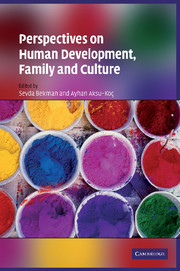Book contents
- Frontmatter
- Contents
- List of figures
- List of tables
- List of contributors
- Preface
- Foreword
- Selected international publications by Çiğdem Kağıtçıbaşı
- I Cultural and cross-cultural psychology: selected perspectives
- II Development in the family context
- 5 Organizing principles and processes from developmental science for culture and caregiving
- 6 A social change and human development perspective on the value of children
- 7 Turkish family structure and functioning
- 8 Mothers' and fathers' child-rearing practices and self-esteem in three generations of urban Turkish families
- III Culture and self
- IV Social change, family, and gender
- V Induced change
- Epilogue
- Subject Index
- Author Index
- References
6 - A social change and human development perspective on the value of children
Published online by Cambridge University Press: 04 August 2010
- Frontmatter
- Contents
- List of figures
- List of tables
- List of contributors
- Preface
- Foreword
- Selected international publications by Çiğdem Kağıtçıbaşı
- I Cultural and cross-cultural psychology: selected perspectives
- II Development in the family context
- 5 Organizing principles and processes from developmental science for culture and caregiving
- 6 A social change and human development perspective on the value of children
- 7 Turkish family structure and functioning
- 8 Mothers' and fathers' child-rearing practices and self-esteem in three generations of urban Turkish families
- III Culture and self
- IV Social change, family, and gender
- V Induced change
- Epilogue
- Subject Index
- Author Index
- References
Summary
For many years, Çiğdem Kağıtçıbaşı has played a prominent role in cross-cultural developmental psychology; she has influenced my own research in this field through her writings and presentations, and by personal exchange. During various meetings she contributed to our joint efforts to make the ongoing Value of Children study possible, and her commitment to cross-cultural research was always a model and an intellectual and motivational encouragement.
Introduction
The Value of Children study continues to be Kağıtçıbaşı's most valued contribution and has recently gained significant new relevance. At present, we can observe a worldwide sociodemographic change that is leading to a reduction in fertility and an increase in longevity in most parts of the world, while the world population is still rising. This phenomenon has, among other questions, stimulated debates about problems of intergenerational relations. One consequence of interest for developmental psychologists is that parents will share an increasing lifetime with their children; related effects on the quality of parent–child relationships over the lifespan are not yet known.
In the 1970s, fear of overpopulation prevailed due to high fertility rates in the poorest countries of the world. This stimulated research on antecedents of demographic changes, such as the famous Value of Children study (Arnold et al. 1975; Fawcett 1972). The original Value of Children study in the 1970s was initiated by the concern of demographers and economists about overpopulation in several parts of the world.
- Type
- Chapter
- Information
- Perspectives on Human Development, Family, and Culture , pp. 86 - 107Publisher: Cambridge University PressPrint publication year: 2009
References
- 9
- Cited by



